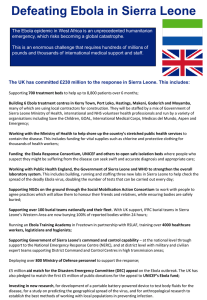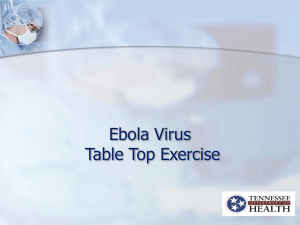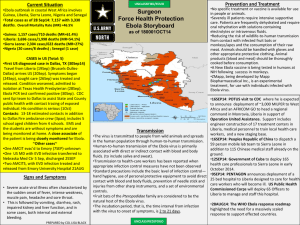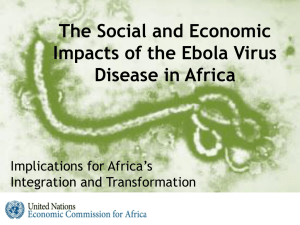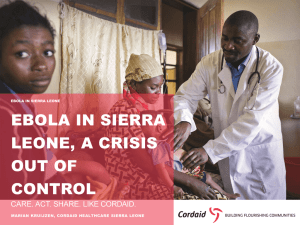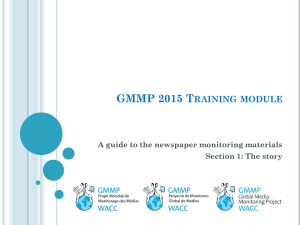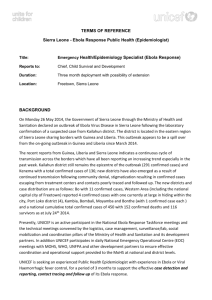As of 26 March 2015, there were 63 Australians registered on
advertisement
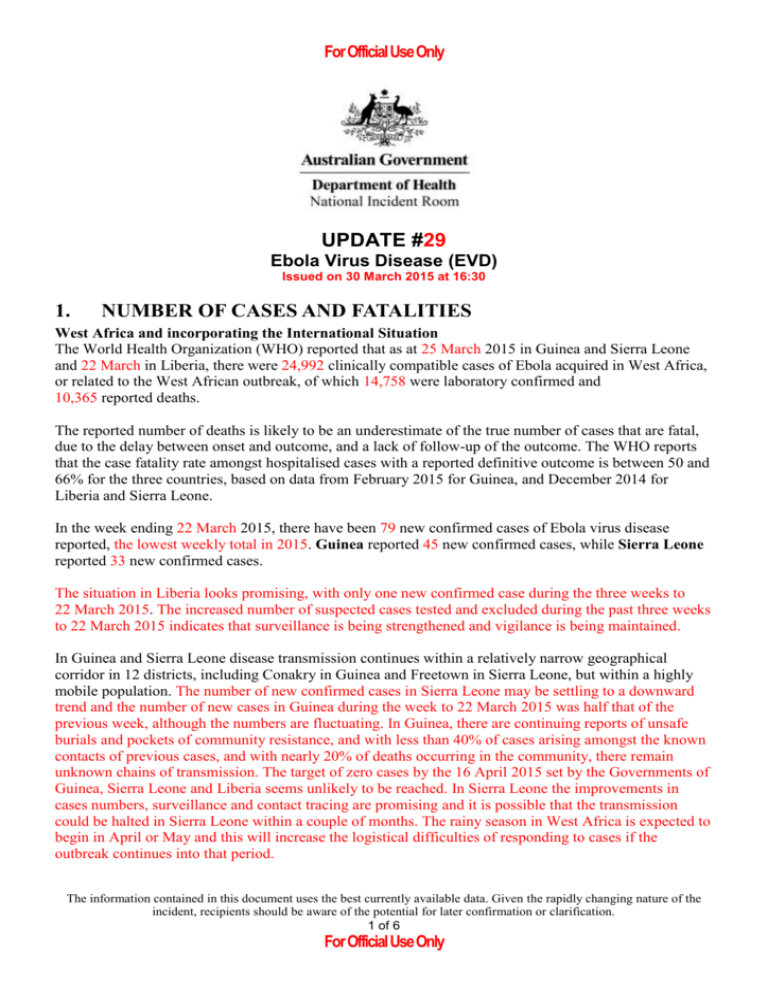
For Official Use Only UPDATE #29 Ebola Virus Disease (EVD) Issued on 30 March 2015 at 16:30 1. NUMBER OF CASES AND FATALITIES West Africa and incorporating the International Situation The World Health Organization (WHO) reported that as at 25 March 2015 in Guinea and Sierra Leone and 22 March in Liberia, there were 24,992 clinically compatible cases of Ebola acquired in West Africa, or related to the West African outbreak, of which 14,758 were laboratory confirmed and 10,365 reported deaths. The reported number of deaths is likely to be an underestimate of the true number of cases that are fatal, due to the delay between onset and outcome, and a lack of follow-up of the outcome. The WHO reports that the case fatality rate amongst hospitalised cases with a reported definitive outcome is between 50 and 66% for the three countries, based on data from February 2015 for Guinea, and December 2014 for Liberia and Sierra Leone. In the week ending 22 March 2015, there have been 79 new confirmed cases of Ebola virus disease reported, the lowest weekly total in 2015. Guinea reported 45 new confirmed cases, while Sierra Leone reported 33 new confirmed cases. The situation in Liberia looks promising, with only one new confirmed case during the three weeks to 22 March 2015. The increased number of suspected cases tested and excluded during the past three weeks to 22 March 2015 indicates that surveillance is being strengthened and vigilance is being maintained. In Guinea and Sierra Leone disease transmission continues within a relatively narrow geographical corridor in 12 districts, including Conakry in Guinea and Freetown in Sierra Leone, but within a highly mobile population. The number of new confirmed cases in Sierra Leone may be settling to a downward trend and the number of new cases in Guinea during the week to 22 March 2015 was half that of the previous week, although the numbers are fluctuating. In Guinea, there are continuing reports of unsafe burials and pockets of community resistance, and with less than 40% of cases arising amongst the known contacts of previous cases, and with nearly 20% of deaths occurring in the community, there remain unknown chains of transmission. The target of zero cases by the 16 April 2015 set by the Governments of Guinea, Sierra Leone and Liberia seems unlikely to be reached. In Sierra Leone the improvements in cases numbers, surveillance and contact tracing are promising and it is possible that the transmission could be halted in Sierra Leone within a couple of months. The rainy season in West Africa is expected to begin in April or May and this will increase the logistical difficulties of responding to cases if the outbreak continues into that period. The information contained in this document uses the best currently available data. Given the rapidly changing nature of the incident, recipients should be aware of the potential for later confirmation or clarification. 1 of 6 For Official Use Only For Official Use Only Sierra Leone has announced a three day lockdown from 27 March to 29 March 2015. As at 22 March 2015, a total of 853 health worker infections have been reported in the three intensetransmission countries, with 494 reported deaths. 2. AUSTRALIAN GOVERNMENT RESPONSE International Australia’s commitment to the international Ebola response is up to $45.55 million. Aspen Medical has been contracted to run an Ebola Treatment Centre (ETC) in Sierra Leone, working in conjunction with the United Kingdom (UK) and New Zealand (NZ). The Government will contribute up to $23 million until up to 30 June 2015 for this treatment centre. The NZ Government has also contributed NZ$2 million (approximately $1.8 million) and up to 24 health workers across a number of rotations to the ETC. As at 25 March 2015 (Sierra Leone time), there had been 193 patients admitted since the Hastings Airfield ETC opened. One hundred and thirty-eight (138) had been discharged (36 Ebola and 102 nonEbola cases) and 55 had passed away (50 Ebola and five non-Ebola related deaths). As at 25 March 2015, there was one suspected case being treated at the Centre. Nineteen (19) Australians are currently working at the Centre, the majority in clinical roles. A doctor is undergoing a 21-day observation period for Ebola in the UK following a clinical incident on 12 March 2015 (Sierra Leone time) at Hastings Airfield ETC. The doctor was transferred to the UK consistent with the agreement secured by the Australian Government on establishing the Centre. The doctor has been tested for EVD on a daily basis since this incident. The doctor has not been diagnosed with Ebola and is not exhibiting any symptoms of Ebola, however, will continue to undergo observation and self-monitoring until 12 April 2015 as agreed with Public Health England. A NZ national who recently returned to NZ after working at Hastings Airfield ETC developed gastroenteritis symptoms on return to NZ. The health care worker has now tested negative for Ebola twice, but will continue to undertake self-monitoring until 29 March 2015. Australia has provided $2 million to RedR Australia to fund the deployment of up to 16 technical experts to short-term non-clinical roles in the United Nations Ebola response. Ten have already deployed. Australia has also provided up to $2 million to support regional response and preparedness efforts led by the WHO. This funding is helping to train health officials in Papua New Guinea, Timor-Leste and Pacific Island Countries in Ebola preparedness measures, enabling the WHO to strengthen the health systems of partner governments in the region. Australia has undertaken an epidemiological study on the risk and possible impacts of an Ebola outbreak in the region. Domestic Additional border screening measures at international airports were introduced from 14 November 2014 including: an updated in-flight announcement – on all inbound flights – and more banners and signage at airports advising of Ebola symptoms; A Travel History Card, completed by all travellers on all inbound journeys, to declare travel from or through an Ebola affected country in the last 21 days. This card is reviewed by Customs and Border 2 of 6 For Official Use Only For Official Use Only Protection officers during the traveller’s arrival processing. Similar questions must also be answered by travellers using SmartGate; If SmartGate identifies that a traveller has travelled to or from an Ebola-affected country in the past 21 days, SmartGate will not process the traveller and they will be directed to a Customs and Border Protection officer for further assessment; Travellers who have been in an Ebola affected country in the last 21 days are directed to biosecurity officials who will ask further questions about their travel and check their temperature; If their temperature is 37.5 degrees Celsius or greater, or they answer yes to one of the screening questions, medical personnel will check the traveller. If the person is unwell medical personnel will take action from that point, following well practiced procedures established alongside the national guidelines to which all states and territories have signed up; Data from the Travel History Card is being recorded to ensure these travellers and their families get the help they need if they are or become unwell and enable tracing of people who may have been exposed if a sick traveller is identified. An Ebola information card is being provided to passengers identified for screening, with a single 1800 number to call in case of future illness. This number is linked to State and Territory public health services on a 24 hour basis; An information pack is provided to all screened passengers providing them with instructions for monitoring their wellbeing and contact details for the public health unit in their state or territory. Similar requirements were implemented for cruise ship passengers and crew from 1 December 2014. The Minister for Immigration and Border Protection has temporarily suspended processing of permanent and some other visa applications from people in Ebola affected countries in Africa until the situation resolves. Applications that are suspended will remain valid for future consideration. Where the applicant demonstrates they present no Ebola-related risks, and subject to meeting other visa requirements, their visa will be processed as per standard practice. People who have already been granted permanent visas, but have not yet travelled to Australia will go through a managed process to provide assurance that they present no risk to the Australian community before they can travel to Australia. In some cases this will require a delay in their travel plans until this can be established. Temporary visas held by people in Ebola affected countries in Africa are being reassessed. This provides an opportunity to assess prior to travel, the likelihood a person has recently been exposed to Ebola, and the risk they pose to Australia. In many cases once this assessment has been made, the person will be able to travel, or will be able to make arrangements to travel at a subsequent time. For existing and future temporary visa applications, these will be assessed for Ebola-related health risks. If there are Ebola-related risks, these applications will be refused. If there are no Ebola-related risks, and subject to other visa criteria being met, temporary visa applications will be processed as per standard practice. 3 of 6 For Official Use Only For Official Use Only For a small number of humanitarian visa holders, yet to arrive in Australia from Ebola affected countries in Africa, the Government has also put in place rigorous arrangements for all future arrivals including a 21 day isolation period and daily health monitoring. Following this isolation period, and if the client does not present with any clinical indications of Ebola, the visa holder will be allowed to travel to Australia. Since the visa arrangements were introduced on 27 October, there have been 155 citizens from Ebolaaffected countries that have entered Australia following appropriate screening. This figure includes 42 arrivals from nationals of DRC between 27 October to 24 November (at which time the country was declared to no longer be Ebola affected) and 113 arrivals of nationals of Guinea, Liberia and Sierra Leone combined. 3. UPDATE ON SCREENING Targeted screening of incoming travellers to Australia commenced on 9 August 2014, and initially included people who commenced their journey from Guinea, Liberia, Sierra Leone and Nigeria, or who had been in Africa in the previous 6 days. People who reported as being unwell or who answered yes to a screening question were referred to a human quarantine officer. On 12 September 2014, the Democratic Republic of the Congo (DRC) was added to the list of countries from which travellers would be screened. On 14 November 2014, enhanced screened measures were implemented, with a 21 day travel history card to identify people who began their journey or had travelled through the affected countries (DRC, Nigeria, Sierra Leone, Guinea, and Liberia). Nigeria was removed from the list of countries screened on 15 November 2014 and DRC on 24 November 2014. Border Screening As at 26 March 2015, there were 1,660 people screened at the border, and of these, 94 were referred to a Human Quarantine Officer. Post Border Screening and Monitoring As at 25 March 2015, there were 19 people being actively monitored for signs and symptoms of Ebola, following potential for exposure to the disease while overseas. As at 25 March 2015, there were 19 people tested for EVD in Australia. All have tested negative. 4. PLANNED ACTIONS Australia’s Chief Medical Officer (CMO) continues to meet with his counterparts in the states and territories to closely monitor the situation overseas and to share information on Australia’s preparedness measures. The Australian Health Protection Principal Committee has endorsed national guidelines for public health management and infection prevention and control including use of Personal Protective Equipment in the event of a case. Relevant agencies (including DFAT, Health and EMA) are implementing the appropriate preparedness measures in Papua New Guinea, Timor-Leste and Pacific Island Countries as set out in the Australian 4 of 6 For Official Use Only For Official Use Only Government Ebola Regional Contingency Plan 2014. An Australian Government Interdepartmental Committee (IDC), co-chaired by Health and the Department of Foreign Affairs and Trade (DFAT) meets on a fortnightly basis to ensure consistent advice and messaging across government. Health is coordinating Ebola specific: Situation Updates Fortnightly agency planning meetings with PM&C, Attorney-General’s Department/Emergency Management Australia, Defence and Department of Foreign Affairs and Trade; monitoring and reporting meetings with border agencies - Agriculture, Customs and Immigration; and updates to Whole of Government Talking Points. 5. ISSUES/MEETINGS According to the European Centre for Disease Prevention and Control, since the beginning of this Ebola epidemic and as of 20 March 2015, there were 65 individuals evacuated or repatriated worldwide from EVD-affected countries. This includes: Thirteen medical evacuations of confirmed EVD-infected patients to Europe: three to Germany, two to Spain, two to France, two to the UK, one to Norway, one to Italy, one to the Netherlands and one to Switzerland Twenty-five asymptomatic people repatriated to Europe due to exposure to Ebola: 13 to UK, three to Sweden, four to Denmark, two to the Netherlands, one to Germany, one to Spain and one to Switzerland Twenty-seven people evacuated to the United States. 6. RISKS The likelihood of an imported case in Australia remains very low given measures in place to identify and assess those most at risk at the border. As of 26 March 2015, there were 63 Australians registered on Smartraveller as being in the three most affected countries (31 in Sierra Leone, 28 in Liberia and four in Guinea). However, this figure may or may not accurately reflect the number of Australians in these countries. 7. FURTHER INFORMATION Department of Health website www.health.gov.au/ebola World Health Organization - http://www.who.int/csr/disease/ebola/en/ DFAT Smartraveller – www.smartraveller.gov.au Health's National Incident Room is NOT currently activated with respect to Ebola. Cleared by: Julianne Quaine, Assistant Secretary, Ebola Response Taskforce Office of Health Protection (02) 6289 3083 5 of 6 For Official Use Only For Official Use Only ATTACHMENT A EBOLA CRISIS IN WEST AFRICA – AUSTRALIA’S RESPONSE SITUATION UPDATE – 27 MARCH 2015 Key messages: One year since the Ebola outbreak began, there have been almost 25,000 reported confirmed, probable or suspected cases and over 10,000 reported deaths. Progress is being made in the fight against Ebola, with a total of 79 new confirmed cases in West Africa reported last week (week to 22 March 2015). This is the lowest weekly total of 2015. The Government of Sierra Leone will run a national “stay at home” campaign from 27-29 March 2015, to enhance public awareness and further reduce the transmission of Ebola, in the lead up to the wet season. Last week, Sierra Leone reported 33 new confirmed cases (previously 55) and Guinea reported 45 new confirmed cases (previously 95). Having reported no new cases for three consecutive weeks, unfortunately Liberia reported a new case on 20 March 2015. In Sierra Leone, there are now many more beds in Ebola treatment centres than patients. While the Government of Sierra Leone is leading a consolidation and rationalisation process. An announcement is expected prior to the end of March 2015. Australia is the 13th largest bilateral donor to the international Ebola response1. HASTINGS AIRFIELD EBOLA TREATMENT CENTRE, SIERRA LEONE Patient numbers at 25 March 2015 Patients currently in ETC 1 (suspected) 362 Patients recovered and discharged Deceased 55 (50 EVD, 5 non-EVD) Patients admitted to date (total) 194 Personnel Australians Other international3 Local Total Management team 6 1 0 7 Clinical team 13 5 136 154 Support staff 0 7 54 61 19 13 190 Total 1 Based on committed funds, subject to complexities relating to currency conversion. This figure only includes EVD patients. A further 102 patients have been discharged after testing negative for EVD. 3 Including citizens of New Zealand and Kenya. 2 6 of 6 For Official Use Only

